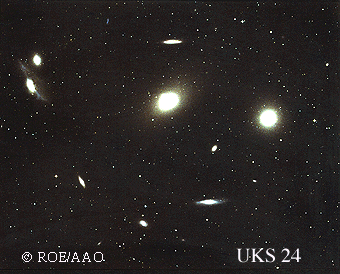
[Image credit: © Anglo-Australian Observatory]
Astronomy 162: Professor Barbara Ryden
Our own galaxy, the Andromeda Galaxy, the Large Magellanic Cloud, the Small Magellanic Cloud, and a couple of dozen other galaxies are all part of a small cluster of galaxies called the Local Group. (In fact, the total number of galaxies in the Local Group is not yet known. Most of the galaxies are hard-to-see dwarf elliptical galaxies and dwarf irregular galaxies. Some of them are hidden behind the dust in our own galaxy, and are thus extraordinarily difficult to discover.) The galaxies in the Local Group are all in orbit around the Local Group's center of mass. Most of the mass (as well as most of the luminosity) in the Local Group is in the two biggest galaxies, our own galaxy and the Andromeda Galaxy. Thus, the center of mass lies between us and Andromeda. The smaller dwarf galaxies in the Local Group are all moving at high speeds, implying that the Group contains a large amount of dark matter.
The Virgo cluster (seen in the image below) is an example
of a moderately rich cluster of galaxies. It contains over 2000 galaxies,
including the giant elliptical galaxy M87. The Virgo cluster
is approximately 15 Mpc away and 3 Mpc in diameter. Since
the Virgo cluster is the nearest rich cluster to us, it
occupies a large region of the sky, about 10 degrees across.

[Image credit: © Anglo-Australian Observatory]
The Coma cluster (in the constellation Coma Berenices) is an example of an extremely rich cluster of galaxies. The Coma cluster contains about 10,000 galaxies. It is approximately 90 Mpc away and 5 Mpc in diameter.
Within rich clusters, there are many elliptical galaxies, but few spiral galaxies. (Spiral galaxies tend to be found in poor clusters like the Local Group.) Near the center of a rich cluster of galaxies, there are usually one or two or three giant elliptical galaxies, containing up to a trillion stars. These huge galaxies sit near the center of the cluster like bloated spiders sitting near the center of their web.
When you look at a cluster at visible wavelengths of light, you see mainly the stars which it contains. However, clusters contain more than stars. For example, X-ray observations show that rich clusters contain very hot gas distributed evenly throughout the cluster. (Since the gas is very hot, the individual atoms are traveling faster than the escape speed from a galaxy.) The Coma cluster is estimated to contain about six times as much mass in very hot gas as in stars. Moreover, the observed high speeds of galaxies within rich clusters show that clusters must contain dark matter. (Without dark matter to anchor the galaxies, the clusters would have flown to pieces billions of years ago.) The Coma cluster is estimated to contain roughly six times as much mass in dark matter as in very hot gas. Thus, the starry galaxies that you see when you look at a photograph of a rich cluster represent only about 2 percent of the cluster's total mass!
The Local Group and the Virgo cluster are both part of the Local Supercluster, a flattened structure which is about 50 Mpc in diameter (thus, it takes light over 160 million years to travel from one edge of the Local Supercluster to the other).
It is possible to map the distribution of galaxies in space out to distances of hundreds of Mpc. The procedure used in making such a map:
Updated: 2003 Feb 26
Copyright © 2003, Barbara Ryden